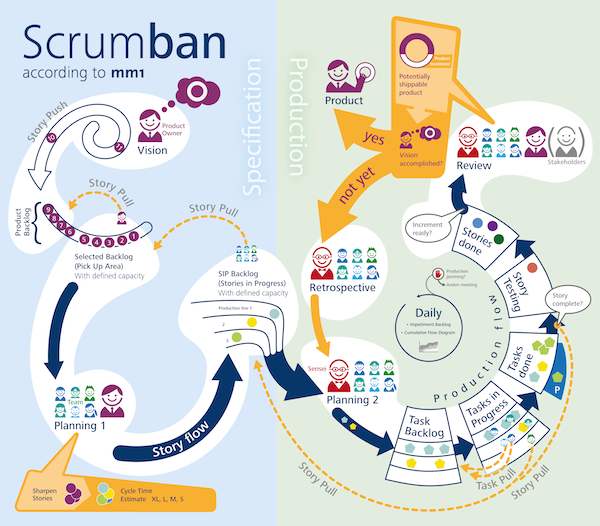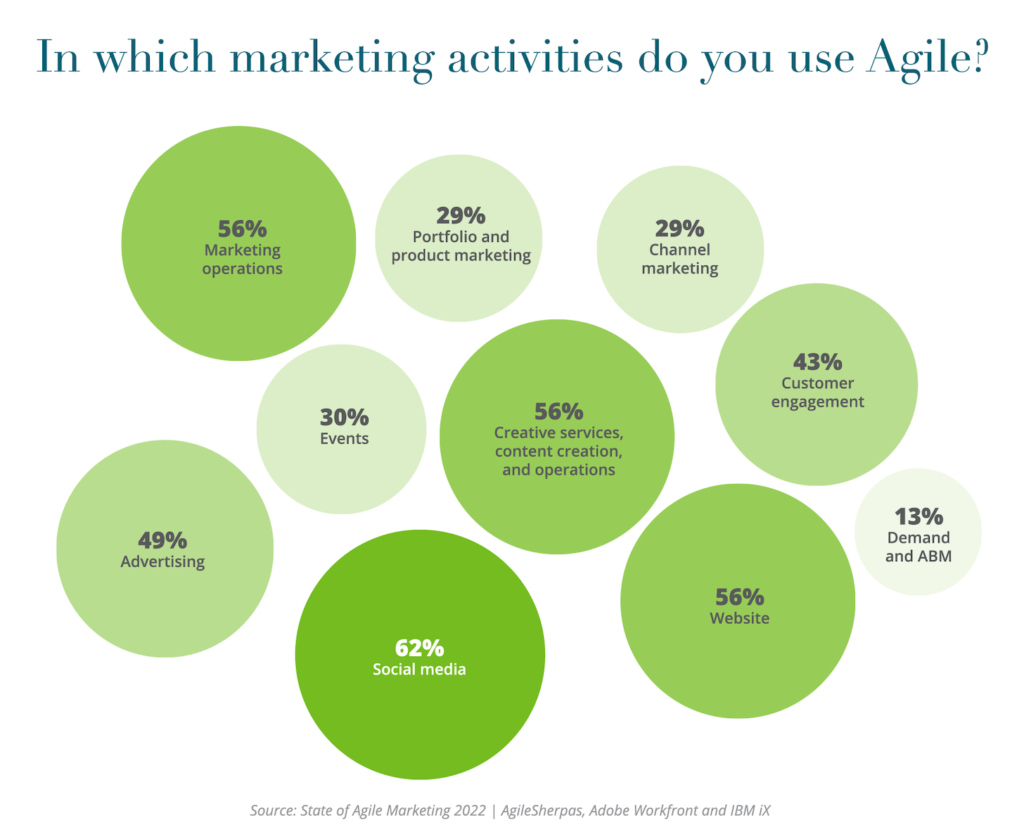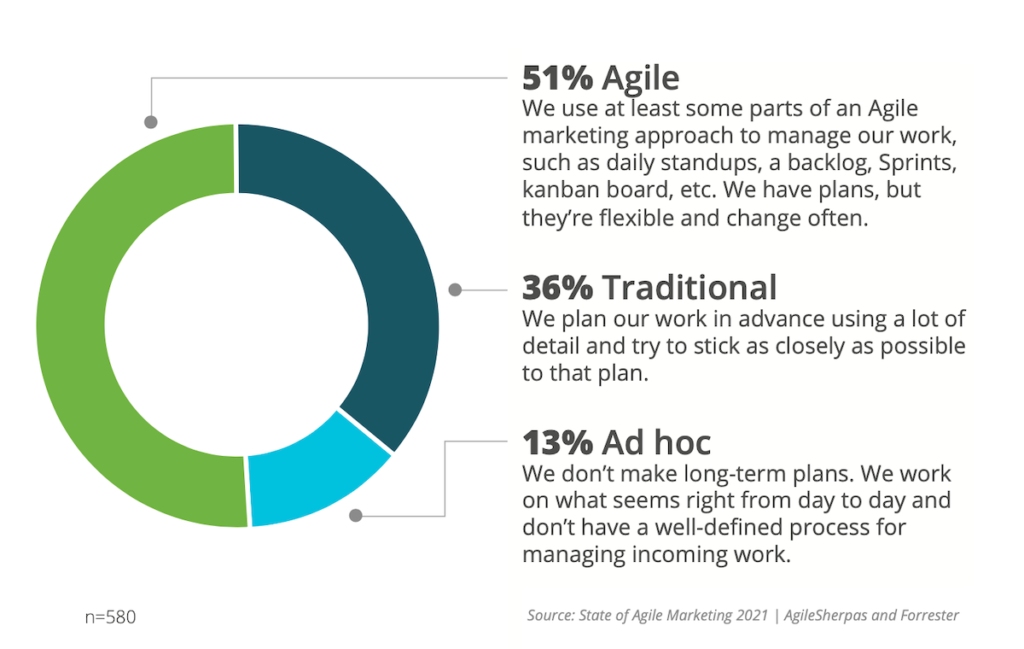

Earlier this year, I had the pleasure of meeting Mark Verone, the Director of Marketing & Product Operations at Gogo, the public company that provides in-flight Internet service on many major airlines and private business aircraft.
I was giving a presentation on marketing trends inspired by technology and technology culture, and I included a section talking about agile marketing. As with almost all of my talks and writing on the subject, I emphasized Scrum as the actual methodology. Variations on Scrum seem to have been the most common approach in agile marketing, and it’s relatively easy to explain.
However, in the Q&A portion of my session, Mark chimed in about the experience he and his team were having with Scrumban — a hybrid of several lean and agile methods, primarily Kanban and Scrum. They actually found this fit better with the flow of their marketing organization.
(By the way, here’s a more detailed introduction to the Scrumban methodology by Corey Ladas, who literally wrote the book. The image at the top of this post is from a Scrumban poster by the consulting company, mm1.)
Hearing more about Mark’s success with Scrumban in his marketing team, I begged him to share his experience in an interview here.
Can you tell us a little about your background and career before Gogo?
You could say that I started working in marketing operations before it had a name. I started my career in the broadcast radio business working as marketing director at the local radio station level, along with direct marketing and research. I was also in a sales support, client services, and a marketing operations role.
My path in radio shifted from the local level to the national level with Clear Channel Communications (now iHeartMedia), where our company grew overnight to 1,200 radio stations. In 1999, they handed me the keys to the advertising technology stack, which at the time consisted of one of the very first ad servers (NetGravity). This was the start of my digital marketing career.
I then moved to Orbitz.com where we setup a global ad serving technology strategy that consolidated the Orbitz brands onto a common ad tech platform to manage advertising inventory across all brands with a centralized yield and inventory management system. I also managed the sales operations side of the house with our Salesforce.com CRM system and various processes.
Can you describe a bit about your current role at Gogo and the way in which marketing technology is managed at Gogo?
I joined Gogo 3 years ago as Director of Ad Operations & Content Management focused on building the ad technology stack and overall ad operations work flow and process. Nothing formally existed with regard to marketing operations until we assembled my team.
I am focused on developing an operational discipline within the Gogo marketing and product teams.
I now serve as Director of Marketing & Product Operations. I am focused on developing an operational discipline within the Gogo marketing and product teams to support our day-to-day activities within the commercial sales and sponsorship arena, along with our in-flight entertainment which offer video-on-demand services with Gogo Vision.
In past 3 years, we have established systems, technology, workflow, automation and processes to streamline a collection of manual tasks. I am proud that we built world’s first IAB-certified, real-time, in-flight ad serving solution, and we continue to optimize various content partnerships across the consumer facing in-flight airline portals.
When we met at a recent conference, you mentioned that your team had been doing agile marketing for a while. How did that get started and what was the initial experience like?
I actually think most marketing teams are more real-time and agile than they believe, without placing a label on it. Marketing tends to be very responsive to the needs of its partners or customers and has no choice but to act in real-time.
[When we transitioned to agile marketing], the biggest challenge was trying to fit the advertising, sponsorships, and marketing calendar into 2-week sprint cycles.
When we made the transition in our company to adopt agile within product and technology, it was easy for my team to hop on board, but we learned a lot along the way. The biggest challenge was trying to fit the advertising, sponsorships, and marketing calendar into 2-week sprint cycles. We tried, but it was very difficult since our time boxes were not aligned to sprints but to contractual commitments and campaign start and end dates.
You mentioned that you moved away from a pure Scrum process to a hybrid of Scrum and Kanban — Scrumban — that you felt worked better in your environment. Can you describe the “special blend” that you came up with?
First, I will not take any credit for Scrumban — this concept was introduced to my team at Gogo from Big Visible, who served as a consultant to our company during the agile transition. They helped us think beyond the 2-week sprint cycle into something that was more adaptive to the needs of the business.
Agile, in general consists of many continuous improvement concepts like Kanban, Lean, Extreme Programming, Feature Driven Development, etc. Scrum on its own consists of time-boxes, roles, rituals and backlogs. The idea of Kanban is a lean manufacturing technique, with roots in the Japanese automotive industry, that leverages visualization and pull techniques. Kanban has 3 rules:
- Visualize your workflow.
- Limit work-in-progress (WIP).
- Analyze and improve the process.
What have you found to be the biggest benefits of working in this Scrumban style of agile marketing? Any challenges that you’re still wrestling with?
It turns out I had been using a variation of Scrumban in my former role at Orbitz, we just did not have a label for it then. The best part of Scrumban is that it leverages a lot of the rituals and terminology used in Scrum, but with the added benefit of customizing things as needed. The other part is that everyone participates and has a voice, and there is complete transparency.
When you can visualize the steps in your workflow, you can immediately start to find areas for improvement or ways to eliminate wasteful steps.
I am a visual person. I like pictures, and I am a Visio nerd. I have 2 giant whiteboards in my office and prefer to draw things out. When you can visualize the steps in your workflow, you can immediately start to find areas for improvement or ways to eliminate wasteful steps. When you map your process and workflow, it also become easier to explain it to the rest of the organization.
The majority of all people are visual learners and this provided a level of transparency like no other. You actually earn more trust and respect from the organization when everyone can see how it all works.
Any advice you’d offer to other marketing technology and operations teams who are thinking about adopting agile management? How should they get started?
First, make sure you have support and buy-in from the top. It is critical that leadership is on board.
Don’t be overwhelmed by the thought of it and don’t “boil the ocean” — start small.
Second, don’t be overwhelmed by the thought of it and don’t “boil the ocean” — start small. Think about repeatable processes in your organization. How can you make those more efficient? We try break our work down into the “Rule of 3” — anything more than 3 steps is too complicated.
Since we act as a service arm to the organization, everything starts with a 1) Request for 2) Work and a 3) Team to complete the work. Requests can be stories or tasks — we think about the type of request, gather details and requirements, and determine resources needed. Work is what needs to get done and the type of work and tools involved with completing the request. Team are the people assigned to complete the work and fulfill the request.
With Scrumban, our time-box is determine by the type of request — we attach lead times to everything to set clear expectations as opposed to custom or new work may require long lead times or a level of flexibility in the time-box.
Thank you, Mark!



Great article! Thank you for sharing. For those who would like to browse some additional articles on using Kanban approach for marketing, take a look at http://kanbantool.com/use-cases/kanban-in-marketing/inbound-marketing.
I would be interested in knowing what Agile/KanBan/Scrum-ban tools that people are using to manage their Marketing Operations. The ones I have seen that look interesting are Aha! and Trello. Any others?
Kurt, try this:
https://www.jetbrains.com/youtrack/
@Kurt, we are using enterprise Kanban Tool for marketing operations and as far as I know our marketing team is pretty happy with it.